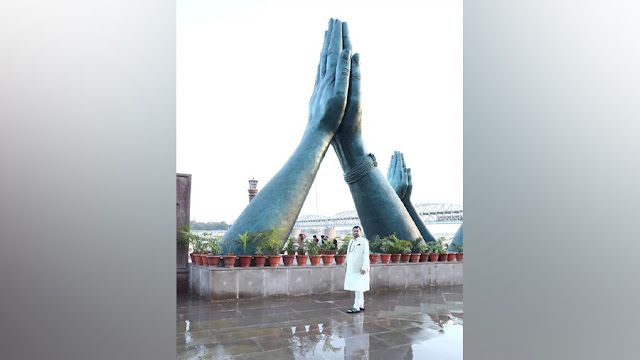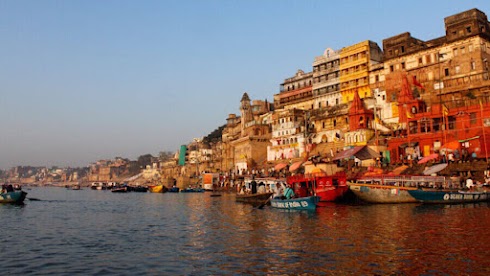VARANASI: A HISTORIC CITY ON THE PATH TO MODERN METAMORPHOSIS
Sundeep Bhutoria writes about his travels in the ancient city of Benaras and how it is moving ahead in a contemporary time

Kashi, Banaras, Benares, Varanasi – all synonyms for one of the oldest continually inhabited cities of this world has history ingrained in its every brick, nook and corner. Named after two tributaries of the mighty Ganges, — Varuna and Assi — that mark the borders of this city in the Bhojpur-Purvanchal region of Uttar Pradesh. Within its hallowed portals lives and breathes a city that is but an embodiment of all things holy, a place of pilgrimage, salvation as well as of education and classical music of the land.
Since ancient times, and even in our contemporary days, endless pages have been written on the city but in all fairness, I choose to refrain from treading the beaten track. Swayed no doubt by the electric atmosphere I, however, would like to focus on things that are more contemporary and perhaps to the many devout here, needlessly mundane.

This is my second visit to Varanasi where I have been invited to an event curated by a few key people of RSS. A few selective speakers from various parts of the country have been asked to speak. My first visit to the ancient city was at a time when Rajnath Singh was the chief minister of the state, and I was present as the youth president of a Marwari organisation. That event was the inauguration by him of the local chapter of the organisation and organised by renowned businessman Ganesh Prasad Lohiya who was in a trade of the famed Banarasi sarees, which incidentally was the predominant trade of city in those days. If compared to the present scenario, things then were a lot different, simple, if I may say so with HHI (Hotel Hindustan International) being the only favourite hotel and Kolkata connect prevailed as the hotel owners, the Jaiswal’s had a hotel in Kolkata, the all too familiar HHI of AJC Bose Road.

But the city as it unfolded before me in this recent visit was vastly different from how I had remembered it. Much has been written about how Varanasi has changed courtesy Prime Minister Narendra Modi’s personal interest in “Swachh Kashi Sundar Kashi”. Changes on the religious front largely include the ‘Kashi Vishwanath Temple Corridor’, cleaning of the Ganga and other admirable initiatives that are quite evident. But another change has also taken place, one which is a direct result of the huge influx of visitors. Bursting at the seams, most hotels are unable to deal satisfactorily with the footfall and this naturally has led to a huge spurt in hotel tariff with some premium hotels charging anything between Rs 60,000 to even well over a lakh per day. The state government has taken some admirable steps to solve this issue but more on that in a while.

The purpose of my second visit to Varanasi is courtesy an invitation to the three day ‘Kashi Shabdoutsav’ which was being staged at the Rudraksh International Cooperation and Convention Centre – Uttar Pradesh’s unique and state of the art conference centre built with Japanese aid via Japan International Cooperation Agency (JICA). Built in the shape of a Shivling, this well-equipped convention centre, comprising a main hall with a seating capacity of 1,200, a gallery, meeting rooms, and parking for over a hundred cars is something that all must see. What pleased me more was when I learned that no freebies are granted to anyone by this centre and not even the highest government office can circumvent the rather stiff charges which must be borne by some department in the respective ministries. Of all the changes which modern Varanasi was imbibing each day, this surely had to be among the foremost of them. The Varanasi of yore is accepting a new feather — emerging as a new city for convention-style events. And how beautifully that new design is becoming a reality.
Here, credit must also be given to the Uttar Pradesh Tourism Department, which in collaboration with private organisations, has created ‘Niraan’ – an entire tent city on the banks of the river where a luxurious and unforgettable stay is being offered. Operational during the months of January and May, this ‘impromptu’ resort offers a pleasant alternative to the difficulties faced while finding a place to stay at Varanasi. The 140-odd tents have been divided into four categories but are all equipped with every modern facility, a personal stretch of the riverbank and of course, a very personal picturesque view of Varanasi city and the ghats. There is however one catch – at the time of my visit there wasn’t a single tent that was vacant and as I was told, there hardly ever is one.

I stayed at the His Highness Vibhuti Narain Singh Suite at Taj Nadesar Palace. Nadesar Palace is the smallest in terms of inventory out of the Taj Palace properties and has only fourteen keys. They are all of different designs and have played host to legendary personalities like the Prince and Princess of Wales, who later became King George V and Queen Mary, Queen Elizabeth II, King Ibn Saud of Saudi Arabia, Lord Mountbatten, Jawaharlal Nehru and His Holiness Dalai Lama. The suites are also named after patrons who once stayed in them. In fact, the suite where I stayed had played host to none other than Hilary Clinton herself. There is little doubt that of all the Taj Palace properties this one most certainly is the crème-de-la-crème of them all. Having travelled extensively, and having stayed at the very best hotels in the country and beyond, over extensive stretches I believe I am very justified in making the above observation. To put it mildly, the hotel is as exclusive as can be and has history in every inch of its presence. Constructed in the 1700s by the East India Company, this palace is a “splendid piece of Neo-classical architecture, with a large porte-cochere out front, and a magnificent porticoed balcony out back.”

For those who harbour an interest in the colonial past there are countless antiques and other works of art that can be admired for hours on end. The palace happened to be in the possession of Maharajah Prabhu Narain Singh of the Royal House of Benares till it eventually came to be acquired by the Taj Group of Hotels. Of all the attractions here, there are also the palace grounds that one may tour and here comes up something that captured my imagination instantly. To me, the hotel’s top draw would have to be Naseem Mohammed and his horse drawn buggy that appears to have withstood the test of time. It is a 150-year-old tradition that began with his grandfather Late Ghosi Budao, and then went on with his father Late Gafur Mohammed. Naseem Mohammed is living through the third generation of the royal buggy drivers. His ride across the property not only informs but transports one back to days long gone by.

Apart from what the appealing sights, how can I not include the pure joy that I experienced while savouring what Varanasi is also famous for —food. A visit to Varanasi is never complete without a food trail and here the most critical of foodies would accept that chaat in Varanasi is but the very best. My trips to Kashi Chat Bhandar, Shree Ram Bhandar, Deena Chat Bhandar at every given opportunity compels me to state that the chaat of Varanasi is indeed excellent and exotic, and very deserving of its worldwide appreciation. And yes, there is no way that you can get it packed to eat later in Nadesar Palace or in Brijdham, you must eat there on the streets itself. I also visited the old and iconic Laxmi tea stall located in the old bylane near Kashi Vishwanath temple which serves Calcutta-style tea and butter malai toast.

Finally, before I conclude, a word on the inevitable country boat ride on the Ganges, seeing the many ghats while floating on the age-old ‘creations’ that appear to have remained unchanged over civilisations is but a foregone conclusion. I submitted to the lure as well but couldn’t help reflecting on how much more needs to be done for tourism purposes. Yes, the government’s four modern boats, able to seat 50 odd travellers in air-conditioned comfort, were on view but clearly, they were far too insufficient given the massive footfall each day, every year. Fluent as he was in many foreign languages, my guide did not have an answer to my query of ‘why no proper boats were being brought in’. Perhaps, the days ahead would see that happening as well but for the moment, one and all, me included, remain happy to be mesmerised by the spectacle of the Ganga aarti while the timeless city of Varanasi prepares to quietly undergo a modern metamorphosis. The most precious memory that I carried back with me from this trip — the unforgettable time that I spent with the legendary Padma Vibhushan recipient Pandit Chhanu Lal Mishra, whom I was meeting after a long time while he was recuperating at this home after a foot surgery.


 June 27, 2023
June 27, 2023